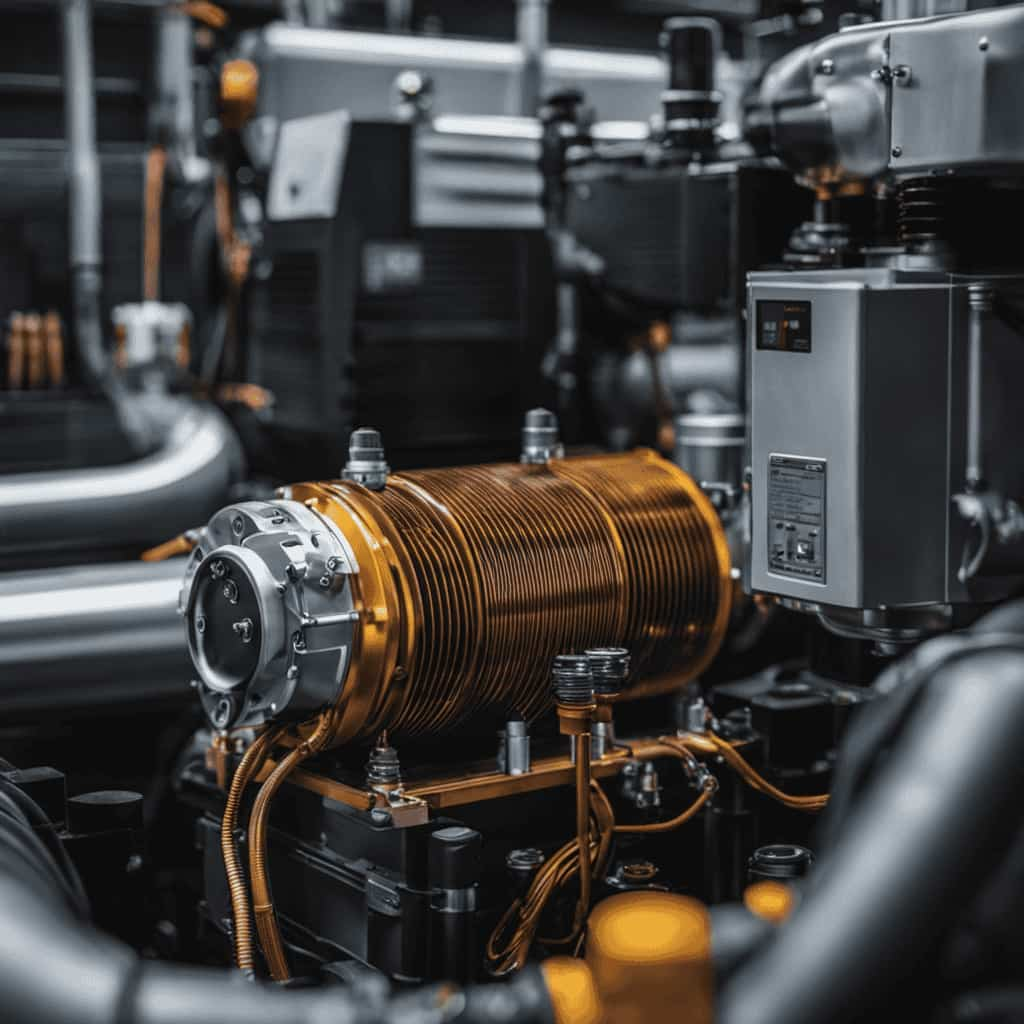Energy Efficiency
Mastering Heat Pump Integration for Eco-Friendly Homes

Do you feel frustrated by expensive energy bills and a harmful carbon footprint? Look no further, we have the solution for you.
In this article, we will guide you through the ins and outs of heat pump integration for eco-friendly homes. Imagine having a system that not only keeps your home comfortable but also reduces your energy consumption.
With our expert tips and tricks, you’ll be well on your way to mastering heat pump integration and creating a more sustainable future.
Key Takeaways
- Heat pump integration offers energy efficiency and cost-effectiveness.
- Proper maintenance ensures longevity and efficiency.
- Implement smart thermostat controls for efficient operation.
- Skilled technicians seamlessly integrate heat pump systems into homes.
Understanding the Basics of Heat Pump Integration
Let’s start by exploring the fundamentals of heat pump integration. Heat pump technology advancements have revolutionized the way we heat and cool our homes, offering numerous benefits for eco-friendly living. Heat pumps efficiently transfer heat from one space to another, utilizing a refrigerant system and electrical power. By extracting heat from the air, ground, or water, they provide both heating and cooling capabilities, making them versatile and cost-effective solutions.

One of the key benefits of heat pump integration is its energy efficiency. Compared to traditional heating and cooling systems, heat pumps consume less energy, reducing utility bills and carbon emissions. Additionally, heat pumps provide consistent comfort throughout the year, maintaining optimal indoor temperatures regardless of external weather conditions. This not only enhances living comfort but also improves air quality by effectively filtering and circulating air.
In recent years, heat pump technology has advanced significantly, resulting in higher performance and improved reliability. Manufacturers have introduced features like variable-speed compressors and smart controls, enhancing efficiency and allowing for greater customization. These advancements have made heat pump integration more accessible and appealing for homeowners seeking sustainable heating and cooling solutions.
Selecting the Right Heat Pump for Your Eco-Friendly Home
We need to consider various factors when selecting the right heat pump for our eco-friendly home. Heat pump sizing is an important aspect to consider, as it ensures that the heat pump is capable of meeting the heating and cooling demands of our home. To determine the appropriate size, we should take into account the square footage of our home, climate conditions, insulation, and the number of occupants. Additionally, it is crucial to know and follow proper maintenance tips to ensure the longevity and efficiency of our heat pump. Regularly cleaning or replacing air filters, inspecting and cleaning the outdoor unit, and scheduling professional maintenance are essential maintenance practices. By carefully considering heat pump sizing and following maintenance tips, we can optimize the performance of our heat pump and contribute to a more sustainable and eco-friendly home environment.
| Factor | Importance | Considerations |
|---|---|---|
| Square footage | High | Larger homes require larger heat pumps to effectively heat and cool the entire space. |
| Climate conditions | High | Harsh climates may require more powerful heat pumps to provide adequate heating and cooling. |
| Insulation | Medium | Well-insulated homes may require smaller heat pumps as they better retain heat or cool air. |
| Number of occupants | Medium | Houses with more occupants may require larger heat pumps to meet the increased demand for heating and cooling. |
| Factor | Importance | Considerations |
|--------------------|----------------------|-----------------------------------------------------------------------------------------------------------------------------------|
| Square footage | High | Larger homes require larger heat pumps to effectively heat and cool the entire space. |
| Climate conditions | High | Harsh climates may require more powerful heat pumps to provide adequate heating and cooling. |
| Insulation | Medium | Well-insulated homes may require smaller heat pumps as they better retain heat or cool air. |
| Number of occupants| Medium | Houses with more occupants may require larger heat pumps to meet the increased demand for heating and cooling. |
Optimizing Energy Efficiency With Heat Pump Integration
To maximize energy efficiency, we can optimize our heat pump integration by implementing smart thermostat controls and regular maintenance.

Smart thermostat controls allow us to set and adjust temperature settings based on our daily routines, ensuring that the heat pump operates efficiently and only when needed. By integrating our heat pump with a smart thermostat, we can also remotely control and monitor our home’s temperature, reducing energy waste and improving indoor air quality.
Regular maintenance is crucial to ensure that the heat pump operates at its peak performance. This includes cleaning or replacing air filters, checking refrigerant levels, and inspecting the system for any issues. By investing in proper maintenance, we can prolong the lifespan of our heat pump, improve its efficiency, and reduce our carbon footprint.
Now, let’s explore the challenges in heat pump installation and integration.
Overcoming Challenges in Heat Pump Installation and Integration
Overcoming challenges in heat pump installation and integration can be achieved by carefully planning and coordinating with experienced professionals. When it comes to efficient installation techniques, there are several key factors to consider:

- Proper sizing: Ensuring that the heat pump is sized correctly for the space is crucial for optimal performance and energy efficiency.
- Ductwork design: Properly designed and sealed ductwork is essential for efficient heat distribution and minimizing energy losses.
- Electrical requirements: Understanding and meeting the electrical needs of the heat pump system is vital to avoid potential issues during installation and operation.
- Troubleshooting common integration issues: Having a comprehensive understanding of common integration issues, such as compatibility with existing heating systems or control system conflicts, allows for prompt identification and resolution of any potential problems.
Maximizing Comfort and Savings With Heat Pump Integration
With proper maintenance and regular usage, homeowners can maximize comfort and savings with heat pump integration by optimizing temperature settings and effectively managing energy consumption. By setting the temperature to a comfortable level, homeowners can ensure a cozy living environment while minimizing energy usage. Additionally, utilizing programmable thermostats allows for automatic adjustment of temperature settings based on occupancy, further maximizing energy savings. Furthermore, homeowners can improve indoor air quality by regularly changing air filters and ensuring proper ventilation. This helps remove pollutants and allergens from the air, creating a healthier living space. By taking these steps, homeowners can enjoy a comfortable and energy-efficient home while also promoting better indoor air quality.
| Tips for Maximizing Comfort and Savings | ||
|---|---|---|
| Optimize temperature settings | Effectively manage energy consumption | Improve indoor air quality |
| Set temperature to a comfortable level for occupants | Utilize programmable thermostats for automatic adjustments | Regularly change air filters |
| Minimize energy usage | Maximize energy savings | Remove pollutants and allergens |
| Ensure a cozy living environment | Save on energy costs | Promote a healthier living space |
Frequently Asked Questions
Are Heat Pumps Suitable for All Types of Homes?
Heat pumps are suitable for most homes due to their efficiency and ability to provide heating and cooling in various climates. They offer numerous benefits, especially in cold climates where they can still operate efficiently.
What Is the Average Lifespan of a Heat Pump?
The average lifespan of a heat pump depends on various factors, including maintenance, usage, and technology advancements. However, with proper care and regular servicing, heat pumps can last for 10-15 years, ensuring long-term heat pump efficiency and eco-friendly home heating.
Can a Heat Pump Be Installed in an Existing Home or Only in New Constructions?
Yes, a heat pump can be installed in an existing home. The installation process involves assessing the home’s heating system, making necessary modifications, and integrating the heat pump. Cost considerations include equipment and labor expenses.

How Much Maintenance Does a Heat Pump Require?
Heat pump maintenance is essential to ensure optimal performance. Regular cleaning and filter replacement prevent common problems such as reduced efficiency and airflow. We recommend scheduling professional inspections annually to address any potential issues promptly.
Are There Any Financial Incentives or Tax Credits Available for Installing a Heat Pump in an Eco-Friendly Home?
Financial benefits and government incentives are available for installing a heat pump in an eco-friendly home. These incentives can help offset the initial cost and make it a more cost-effective and sustainable choice for homeowners.
Conclusion
In conclusion, heat pump integration is a crucial aspect of creating eco-friendly homes. By understanding the basics, selecting the right heat pump, optimizing energy efficiency, and overcoming installation challenges, homeowners can maximize comfort and savings.
As the adage goes, ‘A stitch in time saves nine,’ investing in heat pump integration early on can lead to long-term energy savings and a greener future for all.

Energy Efficiency
Top Energy-Efficient Heat Pump Models Reviewed


We have completed the research and identified the best energy-efficient heat pump models for you.
Get ready to save on your energy bills and keep your home comfortable all year round.
In this article, we’ll be reviewing the Rheem RP20, Lennox XP25, Carrier Infinity 20, Trane XV20i, and Daikin Quaternity heat pumps.
These models are packed with advanced features and cutting-edge technology.
So, sit back, relax, and let us guide you through the world of energy-efficient heat pumps.
Key Takeaways
- The Rheem RP20, Lennox XP25, Carrier Infinity 20, and Trane XV20i are among the top energy-efficient heat pump models available.
- These models feature advanced technologies such as intelligent eye technology, 4-way airflow system, and advanced filtration system, which contribute to energy savings and improved indoor air quality.
- The Daikin Quaternity heat pump stands out for its high SEER rating, superior performance, and ability to handle extreme weather conditions.
- In addition to their innovative features, these heat pump models offer competitive pricing, long-term cost savings, and warranty coverage, making them an excellent choice for energy-efficient heating and cooling.
Rheem RP20 Heat Pump
The Rheem RP20 Heat Pump stands out as an energy-efficient option due to its exceptional performance and range of features. It offers advanced technology and innovative design, ensuring optimal comfort while minimizing energy consumption. The heat pump features a variable-speed motor that adjusts its speed according to the heating or cooling needs of the home, resulting in reduced energy usage and lower utility bills. Additionally, it is equipped with a two-stage compressor, allowing for more precise temperature control and enhanced efficiency. Overall, the Rheem RP20 Heat Pump is a reliable and energy-efficient solution that provides exceptional performance and comfort for any home.
Lennox XP25 Heat Pump
We found the Lennox XP25 Heat Pump to be an excellent choice for energy efficiency due to its innovative features and advanced technology.
Here are some key points that make the Lennox XP25 Heat Pump stand out:

- Variable-capacity operation allows for precise temperature control and reduced energy consumption.
- The XP25 is ENERGY STAR® certified, ensuring high energy efficiency and cost savings.
- It features a SilentComfort™ technology that minimizes noise levels for a quieter operation.
- The unit is equipped with a SunSource® Solar-Ready option, allowing you to harness the power of the sun for even greater energy savings.
- The XP25 comes with the iComfort® S30 smart thermostat, which provides precise temperature control and advanced programming capabilities.
With its cutting-edge technology and energy-efficient design, the Lennox XP25 Heat Pump offers a reliable and cost-effective solution for maintaining a comfortable home environment while reducing energy consumption.
Now, let’s move on to the next heat pump model: the Carrier Infinity 20 Heat Pump.
Carrier Infinity 20 Heat Pump
Now let’s take a look at the Carrier Infinity 20 Heat Pump, which offers exceptional energy efficiency and advanced features. The Carrier Infinity 20 heat pump is known for its impressive energy-saving capabilities and innovative technologies. It is designed to provide optimal comfort while reducing energy consumption.
Here is a table highlighting the pros and cons of the Carrier Infinity 20 heat pump:

| Pros | Cons |
|---|---|
| Excellent energy efficiency | Higher upfront cost |
| Quiet operation | Requires professional installation |
| Advanced features for enhanced comfort | Limited availability of parts |
The Carrier Infinity 20 heat pump incorporates several energy-saving features, including variable-speed technology, which allows the unit to adjust its output based on the heating or cooling demands, resulting in lower energy consumption. Additionally, it utilizes a two-stage compressor, which helps maintain consistent temperatures and reduces energy usage.
In the next section, we will discuss the Trane XV20i heat pump and its energy-efficient features.
Trane XV20i Heat Pump
Let’s dive into the features of the Trane XV20i Heat Pump, known for its energy efficiency and innovative technology. Here is an analysis of its efficiency and a cost comparison:
Efficiency Analysis:

- The Trane XV20i boasts a SEER (Seasonal Energy Efficiency Ratio) rating of up to 22, making it highly efficient in both heating and cooling modes.
- It also has a HSPF (Heating Seasonal Performance Factor) of up to 10, ensuring efficient heat production during colder months.
- With its variable-speed compressor, the XV20i adjusts its output based on the current temperature and demand, optimizing energy usage.
- The unit’s ComfortLink™ II communicating technology allows for precise control and coordination with other HVAC components, further enhancing efficiency.
- The TruComfort™ technology ensures consistent and even temperatures throughout the home, reducing energy wastage.
Cost Comparison:
- While the initial cost of the Trane XV20i may be higher than some other models, its energy efficiency can lead to significant long-term savings on utility bills.
- The variable-speed compressor and precise control capabilities enable the XV20i to operate at lower speeds for longer durations, resulting in reduced energy consumption.
Transitioning into the subsequent section about the ‘daikin quaternity heat pump’, another top energy-efficient model worth exploring is…
Daikin Quaternity Heat Pump
Moving on to the Daikin Quaternity Heat Pump, let’s explore its features and energy efficiency.
The Daikin Quaternity is a highly efficient heat pump model that offers a wide range of benefits. It comes equipped with advanced features such as intelligent eye technology, which detects human presence and adjusts the temperature accordingly to save energy. The Quaternity also boasts a unique 4-way airflow system that ensures even distribution of warm or cool air throughout the room.

In terms of energy efficiency, the Quaternity has a high SEER rating of up to 20.6, making it one of the most efficient heat pumps on the market. When compared to other Daikin heat pump models, the Quaternity stands out for its superior performance and innovative features.
As for pricing, the Daikin Quaternity is competitively priced, offering excellent value for money.
Frequently Asked Questions
What Is the Average Lifespan of These Heat Pump Models?
On average, the lifespan of these heat pump models is around 15-20 years. However, it is important to note that proper maintenance is crucial to ensure the longevity of the unit. Regular servicing and cleaning can significantly extend its lifespan.
Do These Heat Pump Models Come With a Warranty?
Yes, these heat pump models come with a warranty. We understand that warranty coverage is important to guarantee customer satisfaction. Rest assured, our reviewed models offer reliable warranties to protect your investment.

Are These Heat Pump Models Eligible for Any Energy Efficiency Rebates or Incentives?
Yes, these heat pump models are eligible for energy efficiency rebates and incentives. They offer significant energy savings compared to traditional heating methods, making them a cost-effective and environmentally-friendly choice.
Can These Heat Pump Models Be Used in Both Residential and Commercial Settings?
Yes, these heat pump models can be used in both residential and commercial settings. When considering cost, it’s important to note that residential applications typically have lower energy demands compared to commercial settings.
Are These Heat Pump Models Compatible With Smart Home Technology?
Yes, these heat pump models are compatible with smart home technology. They offer seamless smart home integration, allowing users to control and monitor their energy-saving features remotely, providing convenience and efficiency for both residential and commercial settings.
Conclusion
After reviewing the top energy-efficient heat pump models, it’s clear that each of them offers impressive performance and cost savings.

However, one statistic that stands out is the Rheem RP20 Heat Pump’s Seasonal Energy Efficiency Ratio (SEER) rating of up to 20.5. This means it’s highly efficient in cooling and heating, helping homeowners save on energy bills.
Overall, these models provide excellent options for those looking to improve their home’s energy efficiency.
Energy Efficiency
Boost Your Heat Pump Energy Efficiency Effortlessly

Let’s crank up the efficiency of our heat pumps with minimal effort!
In this article, we’ll explore simple yet effective ways to enhance the energy efficiency of your heat pump.
From understanding efficiency ratings to optimizing placement and size, we’ll cover it all.
We’ll also dive into the importance of regular maintenance, smart thermostat technology, and alternative heating methods.

Get ready to maximize your heat pump’s performance effortlessly.
Key Takeaways
- Understanding heat pump efficiency ratings: SEER rating measures cooling efficiency, HSPF rating measures heating efficiency, higher SEER and HSPF ratings indicate better efficiency and greater energy savings.
- Implementing proper heat pump sizing and placement: Proper insulation reduces heat loss, well-insulated homes require smaller heat pumps, consider noise levels and airflow when placing the heat pump, install it away from direct sunlight and heat sources for improved performance and energy efficiency.
- Regular maintenance and cleaning for optimal performance: Clean or replace air filters every 1-3 months, check and clean the outdoor unit twice a year, schedule professional maintenance annually, remove debris and obstructions around the outdoor unit, dust and vacuum the indoor unit regularly.
- Utilizing smart thermostat technology: Smart thermostats optimize energy efficiency by adjusting the temperature based on heating preferences, allowing for temperature scheduling and remote control, offering energy-saving modes and real-time energy usage data, maximizing efficiency and reducing energy costs effortlessly.
Understanding Heat Pump Efficiency Ratings
As we delve into the topic of understanding heat pump efficiency ratings, it’s important to grasp the significance of these ratings in maximizing energy savings. Heat pump SEER (Seasonal Energy Efficiency Ratio) ratings and HSPF (Heating Seasonal Performance Factor) ratings play a crucial role in determining the efficiency of a heat pump.
The SEER rating measures the cooling efficiency of the heat pump, while the HSPF rating measures its heating efficiency. A higher SEER rating indicates better cooling efficiency, while a higher HSPF rating indicates better heating efficiency. Understanding these ratings helps us make informed decisions when choosing a heat pump, as a higher rating means greater energy savings.
By considering both SEER and HSPF ratings, we can ensure that our heat pump operates efficiently throughout the year.

Now, let’s explore how implementing proper heat pump sizing and placement further enhances energy efficiency.
Implementing Proper Heat Pump Sizing and Placement
To ensure optimal energy efficiency, we must carefully determine the correct size and placement of our heat pump. Proper insulation is key to reducing heat loss and ensuring that the heat pump operates efficiently. A well-insulated home will require a smaller heat pump, saving both energy and money.
When it comes to placement, it’s important to consider factors such as noise levels and airflow. The heat pump should be installed in a location that allows for proper air circulation and easy access for maintenance. Additionally, placing the heat pump away from direct sunlight and sources of heat can help prevent overheating and improve its performance.
Regular Maintenance and Cleaning for Optimal Performance
We should regularly maintain and clean our heat pump to ensure optimal performance. By following a maintenance checklist and utilizing effective cleaning techniques, we can prolong the lifespan of our heat pump and maximize its energy efficiency.

Here is a simple maintenance checklist to keep in mind:
| Task | Frequency |
|---|---|
| Clean or replace air filters | Every 1-3 months |
| Check and clean outdoor unit | Twice a year, in spring and fall |
| Schedule professional maintenance | Annually |
In addition to regular maintenance, proper cleaning techniques are essential. Here are some tips:
- Clean the outdoor unit: Remove any debris or leaves around the unit and keep it clear of obstructions to promote proper airflow.
- Clean the indoor unit: Dust and vacuum the indoor unit regularly to prevent dirt buildup that can hinder performance.
- Clean the coils: Use a soft brush or cloth to gently clean the coils, removing any dirt or debris.
Regular maintenance and cleaning will ensure that your heat pump operates at its best. In the next section, we will explore the benefits of utilizing smart thermostat technology.
Utilizing Smart Thermostat Technology
By integrating smart thermostat technology into our heating system, we can optimize energy efficiency and effortlessly control our heat pump.

Smart thermostats provide advanced features that help improve energy consumption and optimize temperature control. These devices can learn our heating preferences and adjust the temperature accordingly, ensuring that our heat pump operates at its most efficient level.
With the ability to program temperature schedules and remotely control the thermostat through smartphone apps, we can easily regulate our heat pump’s operation even when we’re not at home.
Additionally, smart thermostats offer energy-saving modes and provide real-time energy usage data, allowing us to make informed decisions about our energy consumption.
With the use of smart thermostat technology, we can maximize our heat pump’s efficiency and reduce our energy costs effortlessly.

Supplementing Heat Pump Usage With Alternative Heating Methods
Using a few alternative heating methods in conjunction with our heat pump can significantly improve its energy efficiency. Here are some options to consider:
-
Geothermal Heating Benefits:
-
Harness the stable temperature of the earth to provide consistent and efficient heating.
-
Reduce electricity consumption by up to 70% compared to traditional heating systems.

-
Enjoy long-term cost savings and lower carbon emissions.
-
Solar Panel Integration:
-
Install solar panels to generate renewable energy for both heating and electricity needs.
-
Reduce reliance on the grid and lower utility bills.

-
Take advantage of government incentives and tax credits for solar installations.
Frequently Asked Questions
Can I Increase the Energy Efficiency of My Heat Pump by Using Renewable Energy Sources?
Yes, we can increase the energy efficiency of our heat pump by using renewable energy sources. Incorporating solar or geothermal power can reduce reliance on traditional energy and maximize efficiency.
What Are Some Common Mistakes to Avoid When Sizing and Placing a Heat Pump?
When it comes to sizing and placing a heat pump, it’s important to avoid common mistakes. By following best practices, you can ensure optimal efficiency and performance for your heat pump.
Is It Necessary to Hire a Professional for Regular Maintenance and Cleaning of My Heat Pump?
Regular heat pump maintenance by professionals ensures optimal performance and longevity. However, cost-effective DIY cleaning can also be beneficial. It’s important to keep filters clean, check for leaks, and ensure proper airflow for maximum energy efficiency.

How Can a Smart Thermostat Help Improve the Energy Efficiency of My Heat Pump?
A smart thermostat can improve the energy efficiency of our heat pump by utilizing features like programmable schedules and remote control. Integrating our heat pump with a smart thermostat maximizes comfort and reduces energy waste.
Are There Any Government Incentives or Rebates Available for Using Alternative Heating Methods Alongside a Heat Pump?
Yes, there are government incentives and rebates available for using alternative heating methods alongside a heat pump. These incentives encourage the use of renewable energy sources and can help lower your energy costs.
Conclusion
In conclusion, by understanding heat pump efficiency ratings, properly sizing and placing the unit, performing regular maintenance and cleaning, and utilizing smart thermostat technology, you can effortlessly boost your heat pump’s energy efficiency.
Additionally, considering alternative heating methods can further supplement the usage of your heat pump.

By implementing these strategies, you can save energy and maximize the performance of your heat pump, ultimately leading to a more cost-effective and eco-friendly heating solution.
Energy Efficiency
Understanding the Economics of High-Efficiency Heat Pumps

We have exclusive information about the economics of high-efficiency heat pumps. Prepare to analyze the cost-benefit ratio, assess the return on investment, and discover government incentives.
Our article will break down the factors affecting the economic viability of these innovative systems. Whether you’re a homeowner or a business owner, understanding the numbers behind high-efficiency heat pumps is crucial for making informed decisions.
So, let’s crunch some numbers and uncover the economic advantages of these energy-saving powerhouses.
Key Takeaways
- Conducting an economic analysis is crucial for informed decision-making.
- High-efficiency heat pumps offer significant long-term savings.
- Energy savings and reduced environmental impact contribute to a positive return on investment.
- Government incentives and financing options improve economic viability.
The Importance of Economic Analysis in High-Efficiency Heat Pump Installation
We believe that when considering high-efficiency heat pump installation, it’s crucial to conduct an economic analysis.

Economic considerations play a pivotal role in determining the long-term savings and overall cost-effectiveness of such installations.
By conducting a thorough economic analysis, one can assess the upfront costs, operational expenses, and potential savings associated with high-efficiency heat pumps.
This analysis allows for an informed decision-making process, ensuring that the chosen heat pump system aligns with the desired outcomes and budgetary constraints.
Evaluating the economic viability of high-efficiency heat pump installation involves considering factors such as energy efficiency ratings, maintenance costs, and potential utility rebates or incentives.

Additionally, the analysis should assess the projected lifespan of the heat pump system to determine the long-term savings and return on investment.
Understanding the Cost-Benefit Ratio of High-Efficiency Heat Pumps
Our analysis of the cost-benefit ratio shows that high-efficiency heat pumps offer significant long-term savings and a favorable return on investment.
When considering the cost effectiveness of high-efficiency heat pumps, it’s important to look beyond the initial upfront costs. While high-efficiency heat pumps may have a higher initial investment compared to traditional heating systems, the energy savings they provide over time more than make up for this difference.
These heat pumps are designed to operate with maximum efficiency, utilizing advanced technology to minimize energy consumption. This results in lower monthly utility bills, leading to substantial savings over the lifespan of the heat pump.

Additionally, the reduced energy usage helps to decrease the environmental impact, making high-efficiency heat pumps an innovative and sustainable choice for heating and cooling needs.
Factors Affecting the Economic Viability of High-Efficiency Heat Pump Systems
Factors such as energy prices, installation costs, and government incentives play a crucial role in determining the economic viability of high-efficiency heat pump systems.
Energy consumption is a key consideration when evaluating the economic feasibility of these systems. High-efficiency heat pumps are designed to minimize energy usage by efficiently transferring heat from one place to another. By reducing energy consumption, homeowners can significantly lower their utility bills, making the investment in a high-efficiency heat pump system more financially attractive.
Additionally, the environmental impact of high-efficiency heat pumps must be taken into account. These systems produce fewer greenhouse gas emissions compared to traditional heating systems, contributing to a greener and more sustainable future.

Evaluating the return on investment for high-efficiency heat pump installation requires careful consideration of these factors. With lower energy consumption and reduced environmental impact, high-efficiency heat pumps offer a promising solution for both cost savings and environmental stewardship.
Evaluating the Return on Investment for High-Efficiency Heat Pump Installation
When evaluating the return on investment for high-efficiency heat pump installation, it’s important to consider various factors such as energy savings, installation costs, and potential government incentives.
High-efficiency heat pumps offer significant energy savings compared to traditional heating systems. By efficiently transferring heat from the air or ground, these pumps can reduce energy consumption and lower utility bills. Additionally, high-efficiency heat pumps provide long-term benefits by reducing greenhouse gas emissions and promoting sustainability.
While the initial installation costs may be higher than conventional systems, the energy savings over time can offset this expense. Moreover, government incentives such as tax credits or rebates can further enhance the return on investment.

In the following section, we’ll explore government incentives and financing options for high-efficiency heat pumps, which can further improve the economic viability of these systems.
Exploring Government Incentives and Financing Options for High-Efficiency Heat Pumps
To further enhance the economic viability of high-efficiency heat pumps, we’ll now explore government incentives and financing options available. These incentives and financing options can significantly reduce the upfront costs of installing a high-efficiency heat pump system, making it more accessible and affordable for homeowners and businesses alike.
Here are five options to consider:
-
Government grants: Many governments offer grants or financial assistance programs to promote the adoption of energy-efficient technologies, including high-efficiency heat pumps. These grants can help offset the initial investment and encourage more people to switch to these energy-saving systems.

-
Tax credits: Some jurisdictions provide tax credits or deductions for the purchase and installation of high-efficiency heat pumps. These credits can help reduce the overall cost of the system and provide additional savings for the homeowner or business.
-
Low-interest loans: Financial institutions and government agencies often offer low-interest loans specifically for energy-efficient upgrades, including high-efficiency heat pumps. These loans provide favorable terms and repayment options, making it easier to finance the installation of these systems.
-
Energy efficiency programs: Many utility companies offer energy efficiency programs that provide incentives for customers to upgrade to high-efficiency heat pumps. These programs may include rebates, discounts, or other financial incentives to encourage the adoption of energy-saving technologies.
-
Power purchase agreements: In some cases, homeowners or businesses can enter into power purchase agreements with third-party providers. These agreements allow the customer to pay for the energy produced by the high-efficiency heat pump system, rather than the upfront cost of the equipment itself. This can provide a more affordable and flexible financing option.

Frequently Asked Questions
How Does the Efficiency of a High-Efficiency Heat Pump Compare to Traditional Heating Systems?
High-efficiency heat pumps outperform traditional heating systems in terms of efficiency and cost. By utilizing advanced technology, these pumps can achieve higher levels of efficiency, resulting in significant energy savings and lower utility bills.
Are There Any Maintenance or Repair Costs Associated With High-Efficiency Heat Pumps?
Maintenance and repair costs for high-efficiency heat pumps are important factors to consider. Regular maintenance can help prevent major issues, but occasional repair expenses may arise. These costs should be factored into the overall economics of the system.
Can High-Efficiency Heat Pumps Be Used in Both Residential and Commercial Buildings?
Yes, high-efficiency heat pumps can be used in both residential and commercial buildings. They offer energy-efficient heating and cooling solutions for various applications, making them a versatile choice for innovative and sustainable HVAC systems.
Are There Any Environmental Benefits to Using High-Efficiency Heat Pumps?
Using high-efficiency heat pumps has significant environmental benefits. They reduce greenhouse gas emissions and contribute to energy savings. These pumps are a sustainable and innovative solution for both residential and commercial buildings.

What Factors Should Be Considered When Choosing the Right Size High-Efficiency Heat Pump for a Specific Space?
When choosing the right size high-efficiency heat pump, several factors should be considered. These include the square footage of the space, insulation levels, climate conditions, and desired temperature settings.
Conclusion
In conclusion, understanding the economics of high-efficiency heat pumps is crucial for making informed decisions. By analyzing the cost-benefit ratio and evaluating factors such as installation costs, energy savings, and government incentives, we can determine the economic viability of these systems.
With their potential for significant return on investment and the availability of financing options, high-efficiency heat pumps offer a promising solution for efficient and cost-effective heating and cooling.
Embrace the power of these systems and unlock a world of economic benefits.

-

 Residential and Commercial Applications5 months ago
Residential and Commercial Applications5 months agoBest Amana Heat Pump Reviews
-

 Thermal Energy Transfer5 months ago
Thermal Energy Transfer5 months agoBreakthroughs in Modern Heat Pump Systems: Thermal Energy Edition
-

 Residential and Commercial Applications5 months ago
Residential and Commercial Applications5 months agoBest Heat Pump
-

 Geothermal Heat Pumps4 months ago
Geothermal Heat Pumps4 months agoUpgrade Your Comfort with Our Efficient HVAC Systems
-

 Geothermal Heat Pumps4 months ago
Geothermal Heat Pumps4 months agoInnovative Geothermal Heat Pump Manufacturers Revolutionize Energy Efficiency
-

 Air Conditioning3 months ago
Air Conditioning3 months agoExploring Energy-Efficient Air Conditioning Heat Pumps
-

 Thermal Energy Transfer2 months ago
Thermal Energy Transfer2 months agoBoost Your Heat Pump Efficiency: Interactive Guide
-

 Air Conditioning5 months ago
Air Conditioning5 months agoHeat Pumps Outperform Traditional Heating in Energy Use











